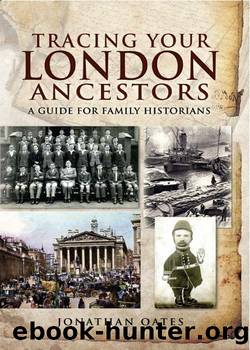Tracing Your London Ancestors by Jonathan Oates

Author:Jonathan Oates [Oates, Jonathan]
Language: eng
Format: epub
ISBN: 9781844686865
Publisher: Pen and Sword
Published: 2012-09-15T07:00:00+00:00
London Hospital, 1900s. Authorâs collection
There is a website, âHospital recordsâ, created by the Wellcome Institute for the History of Medicine and hosted by TNA (www.nationalarchives.gov.uk/hospitalrecords/). It can be searched by name of hospital, and for each one, it gives an administrative history and a list of the records held, with their whereabouts. Having looked at some pages of this site, and after seeing an impressive listing, the author was disappointed to note that, in the instance of Perivale Maternity Hospital, there was a footnote to record that the current whereabouts of the hospital records was unknown â meaning that almost certainly they have been destroyed or lost.
Archives of older hospitals are usually open. Those for the British Lying-In Hospital in Holborn include patient registers for 1749â1868. The hospital was for wives of servicemen and poor married women prior to their giving birth. The motherâs name and dates of admission/discharge/death are given, as is the childâs name and date of birth, and the fatherâs name, occupation and whereabouts. These can be viewed on microfilm at TNA. From 1849, place and date of marriage is also noted. The records can be see online at bmdregisters.com.
There were other hospitals, too, which were funded out of county rates. Asylums for the mentally ill were founded in Middlesex in the nineteenth century. These were initially designed for the pauper insane. The first was the County asylum at Southall, usually (and erroneously) called the Hanwell asylum. This was built in 1829â31 and expanded over the, decades, so that by the end of the nineteenth century, there were about 3, 000 inmates in this enclosed community. Another large asylum was at Colney Hatch, in 1851. As with hospitals, admission and discharge books are the main class of records which are of interest to the family historian, with patientsâ name, address, occupation, date of birth and date of entry and they also state what the patient is suffering from, and what the treatment was. They may record any previous institution the patient had attended and to which subsequent one they were sent. There also may be references to a patientâs condition at regular intervals, as in the case of Aaron Kominski, who has been suspected of being Jack the Ripper. These records are usually closed for 100 years, too.
Private asylums also existed around London. These were for those whose friends and relations could pay fees. They tended to be small-scale institutions, dealing with numbers in single or double figures. Dr John Conolly (1794â1866), who had been superintendent of the County asylum mentioned in the paragraph above, opened his own private asylum in Hanwell, which he ran for two decades, and a mile west of the county asylum was Southall Park, which was run as a private Asylum in 1838â83. However, records do not survive of these, and only the census returns will list patients, and then, often by initials only.
The main problem with hospital records is that you need to know where your ancestor might have been treated.
Download
This site does not store any files on its server. We only index and link to content provided by other sites. Please contact the content providers to delete copyright contents if any and email us, we'll remove relevant links or contents immediately.
Crazy Rich Asians by Kevin Kwan(9135)
Small Great Things by Jodi Picoult(6877)
Spare by Prince Harry The Duke of Sussex(5004)
Too Much and Not the Mood by Durga Chew-Bose(4237)
Machine Learning at Scale with H2O by Gregory Keys | David Whiting(3984)
Never by Ken Follett(3716)
Harry Potter 02 & The Chamber Of Secrets (Illustrated) by J.K. Rowling(3604)
I'll Give You the Sun by Jandy Nelson(3335)
The Ultimate Backcountry Survival Manual by Aram Von Benedikt; Editors of Outdoor Life;(3191)
Fairy Tale by Stephen King(3164)
The Man Who Died Twice by Richard Osman(2963)
Fantastic Beasts and Where to Find Them: Illustrated edition by J.K. Rowling & Newt Scamander(2952)
Reminders of Him: A Novel by Colleen Hoover(2874)
The One Memory of Flora Banks by Emily Barr(2754)
Will by Will Smith(2745)
Beautiful Disaster 01 by Jamie McGuire(2731)
Harry Potter and the Deathly Hallows (7) by J.K. Rowling(2616)
Hooked: A Dark, Contemporary Romance (Never After Series) by Emily McIntire(2470)
Photographic Guide to the Birds of Indonesia by Strange Morten;(2469)
